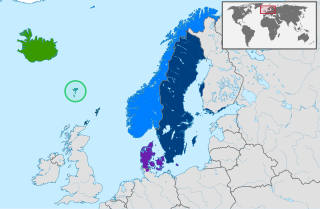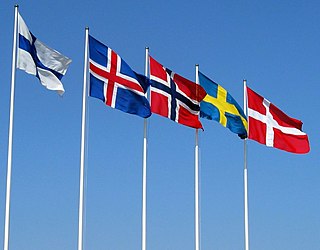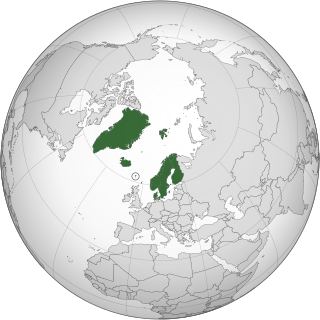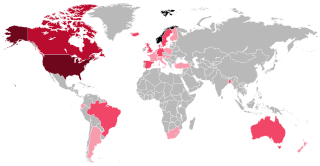
Scandinavia is a subregion of Northern Europe, with strong historical, cultural, and linguistic ties between its constituent peoples. Scandinavia most commonly refers to Denmark, Norway, and Sweden. It can sometimes also refer to the Scandinavian Peninsula. In English usage, Scandinavia is sometimes used as a synonym for Nordic countries. Iceland and the Faroe Islands are sometimes included in Scandinavia for their ethnolinguistic relations with Sweden, Norway and Denmark. While Finland differs from other Nordic countries in this respect, some authors call it Scandinavian due to its economic and cultural similarities.

The Nordic Council is the official body for formal inter-parliamentary Nordic cooperation among the Nordic countries. Formed in 1952, it has 87 representatives from Denmark, Finland, Iceland, Norway, and Sweden as well as from the autonomous areas of the Faroe Islands, Greenland, and Åland. The representatives are members of parliament in their respective countries or areas and are elected by those parliaments. The Council holds ordinary sessions each year in October/November and usually one extra session per year with a specific theme. The council's official languages are Danish, Finnish, Icelandic, Norwegian, and Swedish, though it uses only the mutually intelligible Scandinavian languages—Danish, Norwegian, and Swedish—as its working languages. These three comprise the first language of around 80% of the region's population and are learned as a second or foreign language by the remaining 20%.

The North Germanic languages make up one of the three branches of the Germanic languages—a sub-family of the Indo-European languages—along with the West Germanic languages and the extinct East Germanic languages. The language group is also referred to as the Nordic languages, a direct translation of the most common term used among Danish, Faroese, Icelandic, Norwegian, and Swedish scholars and people.

The northern region of Europe has several definitions. A restrictive definition may describe northern Europe as being roughly north of the southern coast of the Baltic Sea, which is about 54°N, or may be based on other geographical factors such as climate and ecology.
Nordic folk music includes a number of traditions of Nordic countries, especially Scandinavian. The Nordic countries are Iceland, Norway, Sweden, Denmark and Finland.

A Nordic cross flag is a flag bearing the design of the Nordic or Scandinavian cross, a cross symbol in a rectangular field, with the centre of the cross shifted towards the hoist.

The Nordic Passport Union allows citizens of the Nordic countries—Iceland, Denmark, Norway, Sweden, and Finland—to travel and reside in another Nordic country without any travel documentation or a residence permit. Since 25 March 2001, all five states have also been in the Schengen Area.
Danish Canadians are Canadian citizens of Danish ancestry. According to the 2006 Census, there were 200,035 Canadians with Danish background, 17,650 of whom were born in Denmark.
Nordic and Scandinavian Americans are Americans of Scandinavian and/or Nordic ancestry, including Danish Americans, Faroese Americans, Finnish Americans, Greenlandic Americans, Icelandic Americans, Norwegian Americans, and Swedish Americans. Also included are persons who reported 'Scandinavian' ancestry on their census. According to 2021 census estimates, there are approximately 9,365,489 people of Scandinavian ancestry in the United States.

Scandinavian studies or Scandinavistics is an interdisciplinary academic field of area studies, mainly in the United States and Germany, that primarily focuses on the Scandinavian languages and cultural studies pertaining to Scandinavia and Scandinavian language and culture in the other Nordic countries. While Scandinavia is defined as Denmark, Norway and Sweden, the term Scandinavian in an ethnic, cultural and linguistic sense is often used synonymously with North Germanic and also refers to the peoples and languages of the Faroe Islands and Iceland; furthermore a minority in Finland are ethnically Scandinavian and speak Swedish natively.
The Somali diaspora or Qurbajoogta refers to Somalis who were born in Greater Somalia and reside in areas of the world that they were not born in. The civil war in Somalia greatly increased the size of the Somali diaspora, as many Somalis moved from Greater Somalia primarily to Europe, North America, Oceania and South Africa. There are also small Somali populations in Asia. The UN estimates that in 2015, approximately 7 million people from Somalia were living outside of the country's borders.
Nordic and Scandinavian people in the United Kingdom refers to people from the Nordic countries who settled in the United Kingdom, their descendants, history and culture. There has been exchange of populations between Scandinavia and Great Britain at different periods over the past 1,400 years. Over the last couple of centuries, there has been regular migration from Scandinavia to Great Britain, from families looking to settle, businesspeople, academics to migrant workers, particularly those in the oil industry.

The Nordic model comprises the economic and social policies as well as typical cultural practices common in the Nordic countries. This includes a comprehensive welfare state and multi-level collective bargaining based on the economic foundations of social corporatism, and a commitment to private ownership within a market-based mixed economy – with Norway being a partial exception due to a large number of state-owned enterprises and state ownership in publicly listed firms.

The Nordic countries are a geographical and cultural region in Northern Europe and the North Atlantic. It includes the sovereign states of Denmark, Finland, Iceland, Norway and Sweden; the autonomous territories of the Faroe Islands and Greenland; and the autonomous region of Åland.
Nordic and Scandinavian Canadians are Canadian citizens with ancestral roots in the Nordic countries and/or Scandinavia

The Norwegian diaspora consists of Norwegian emigrants and their descendants, especially those that became Norwegian Americans. Emigrants also became Norwegian Canadians, Norwegian Australians, Norwegian New Zealanders, Norwegian Brazilians, Kola Norwegians and Norwegian South Africans.
The Nordic diaspora may refer to:
Nordic Australians are Australian citizens whose origins are found in any of the Nordic countries, or people from any of these countries who live in Australia. Danish immigrants made up the largest group by far.

The Almost Nearly Perfect People: The Truth About the Nordic Miracle is a 2014 nonfiction book by the British journalist Michael Booth. In the book, Booth focuses on the five Nordic countries—Denmark, Iceland, Norway, Finland and Sweden—dedicating a section of the book to each one.
The Albanians in the Nordic countries refers to the Albanian migrants in Nordic countries such as Denmark, Faroe Islands, Finland, Norway and Sweden and their descendants.
 Danish New Zealanders estimate: 1,986 [1]
Danish New Zealanders estimate: 1,986 [1]  Icelandic New Zealanders estimate: 120 [2]
Icelandic New Zealanders estimate: 120 [2]  Norwegian New Zealanders estimate: 810 [3]
Norwegian New Zealanders estimate: 810 [3]  Swedish New Zealanders estimate: 1,404 [4]
Swedish New Zealanders estimate: 1,404 [4]  Finnish New Zealanders estimate: 783 [5]
Finnish New Zealanders estimate: 783 [5] 














